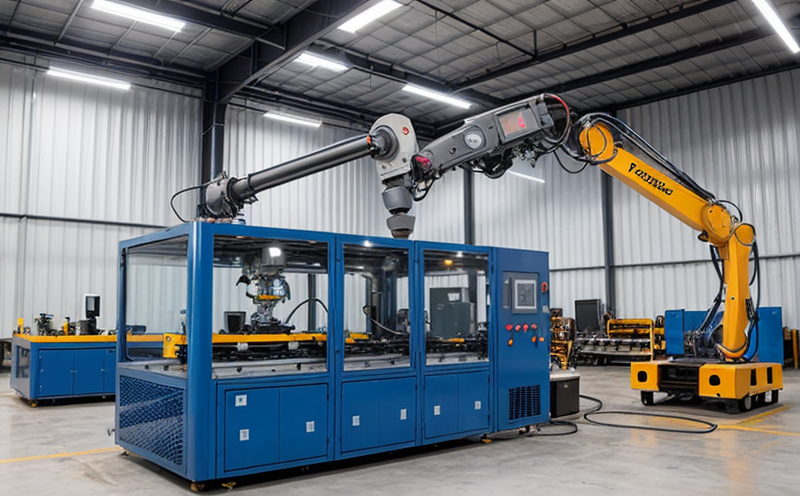ISO 26262 Functional Safety Testing of Robotic Vehicles
The International Organization for Standardization's (ISO) ISO 26262 standard is a cornerstone in the automotive industry, providing guidelines to ensure that functional safety requirements are met throughout the lifecycle of vehicles. This includes robotic systems used in manufacturing and processing environments. The standard ensures that potential risks associated with vehicle operation are identified, assessed, and mitigated appropriately.
Robotic systems within industrial manufacturing and processing contexts must meet stringent reliability and safety standards to ensure they operate seamlessly and safely alongside human workers or in autonomous capacities. These robotic vehicles often integrate advanced sensors, actuators, and control algorithms that require rigorous testing to ensure their operational integrity and safety compliance.
The ISO 26262 standard defines a risk-based approach to functional safety, which involves the following key steps:
- Risk assessment
- Conceptual design
- Safety requirements specification
- System architecture design
- Software and hardware design
- Implementation, integration, and test
In the context of robotic vehicles used in industrial manufacturing and processing environments, this involves testing various aspects including:
- Safety functions: Ensuring that all safety-critical functions operate as expected.
- Fail-safety requirements: Verifying that failures do not lead to hazardous situations.
- Hazard analysis and risk assessment (HARA): Identifying potential hazards and assessing risks associated with robotic vehicle operations.
The testing process involves a series of detailed steps designed to evaluate the robustness, reliability, and safety of these systems. This includes:
- Initial risk assessment using hazard analysis techniques such as Failure Mode and Effects Analysis (FMEA) or Hazard and Operability Study (HAZOP).
- Developing a functional safety concept for the robotic vehicle.
- Identifying all safety-critical requirements that must be met to ensure the system operates safely within its intended environment.
- Designing and implementing the system architecture, ensuring it meets ISO 26262 compliance.
- Testing each component of the robotic vehicle to ensure they meet their specified functional safety requirements.
The testing process is highly technical and requires specialized equipment, including:
- Advanced simulation software for virtual testing
- Real-world test beds that replicate industrial environments
- Safety-critical test rigs capable of simulating failure modes and operational scenarios
The testing process aims to cover all aspects of the robotic vehicle’s operation, including:
- Operational safety: Ensuring that the robotic vehicle can operate in a safe manner under expected conditions.
- Hazardous situations management: Identifying and mitigating potential hazards during operation.
- Fail-safety requirements compliance: Verifying that failures do not lead to hazardous outcomes.
The results of these tests are documented in detailed reports, which include:
- Test protocols and procedures
- Test results and analysis
- Compliance with ISO 26262 standards
- Recommendations for further improvements or modifications
This comprehensive approach ensures that robotic vehicles used in industrial manufacturing and processing environments are safe, reliable, and compliant with the latest international safety standards.
Benefits
Implementing ISO 26262 functional safety testing for robotic vehicles offers several key benefits:
- Enhanced Safety Compliance: Ensures that all safety-critical functions are tested and validated to meet the highest international standards.
- Improved Product Quality: By adhering to rigorous testing protocols, potential defects can be identified early in the development process.
- Increased Customer Satisfaction: Compliance with ISO 26262 demonstrates a commitment to safety and quality, which enhances customer trust and satisfaction.
- Cost Efficiency: Early identification of issues through rigorous testing can prevent costly rework or recalls later in the product lifecycle.
- Achieving Regulatory Compliance: Ensures that all products meet regulatory requirements, avoiding potential legal and financial penalties.
- Innovation Support: The structured approach of ISO 26262 allows for continuous improvement and innovation in robotic vehicle design and functionality.
These benefits contribute to the overall success of industrial manufacturing processes, ensuring that robotic vehicles operate safely and efficiently within complex environments.
Customer Impact and Satisfaction
The implementation of ISO 26262 functional safety testing for robotic vehicles has a direct impact on customer satisfaction in several ways:
- Increased Trust: Customers are more likely to trust products that meet international safety standards, enhancing brand reputation.
- Prompt Issue Resolution: By identifying and addressing issues early in the development process, customers receive reliable and safe products from the outset.
- Enhanced Product Quality: Compliance with ISO 26262 ensures that robotic vehicles meet high quality standards, leading to improved customer satisfaction.
- Regulatory Assurance: Meeting regulatory requirements reduces the risk of non-compliance penalties and ensures legal compliance, which is crucial for maintaining customer confidence.
These factors contribute to higher levels of customer satisfaction, fostering long-term relationships and loyalty.
Use Cases and Application Examples
The ISO 26262 functional safety testing for robotic vehicles is particularly relevant in various industrial sectors where complex robotic systems are employed. These include:
- Automotive manufacturing: Ensuring that automated assembly lines and quality control systems operate safely.
- Material handling: Testing robotic arms and conveyors used in warehousing and logistics operations.
- Pharmaceutical production: Verifying the safety of automated dispensing systems and packaging machines.
- Food processing: Ensuring that robotic systems involved in food preparation and packaging meet strict hygiene and safety standards.
In each of these use cases, the testing process involves:
- Hazard identification: Identifying potential hazards associated with the operation of robotic vehicles.
- Risk assessment: Assessing the likelihood and impact of identified risks.
- System design: Developing a system architecture that incorporates safety features and meets ISO 26262 standards.
The testing process is crucial in ensuring that robotic vehicles operate safely within their intended environments, thereby enhancing overall industrial efficiency and reliability.





